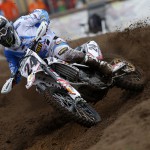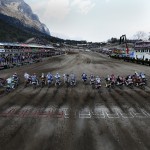At the start of the year I spoke about the general feeling within the WorldSBK press room that Chaz Davies was a hot tip for the 2016 title. Most people had based that on his end of 2015 form but that promise hasn’t really materialised and a series of DNF’s mid season put paid to any serious challenge to the Ninja masters, Rea and Sykes.
That series of hiccups seems to have passed and the Welshman has won three from the last four races, and as was pointed out, they were all different; the dominant win in Lausitz followed by the tactical wet-dry race on Saturday and the patient victory on Sunday where he stalked the Kawasaki team-mates and waited until they inevitably tripped each other up.
Saturday’s race at Magny Cours was utterly enthralling. As we all scurried about on the grid the sun came out and immediately started to dry the sodden track. Almost everyone went for a full wet set up. Davies went for inters and after a couple of laps was languishing at the back of the field amongst the perennial also-rans.
It was a real privilege to watch from trackside as, at the front, Leon Camier and Alex De Angelis stayed the course on their wet set up and were riding right on the limit. Through my long lens I could see the bike moving around so much as the rain tyres started to overheat and edge grip became a luxury instead of an everyday staple. It was particularly noticeable as they exited the long left hander at Turn 8 which, under hard acceleration, is followed by an immediate change of direction, right and back left again onto the drag up to Imola. To watch these guys ride with such aggression and skill at close quarters really is awe-inspiring.
In the end Davies’ gamble paid off and like the fabled tortoise, albeit a very very fast one, he made his way through the field and romped home for the win.
Sunday’s race was a bit more standard fare but Sykes was perplexed at his team-mate’s aggressive riding in the closing laps which resulted in Davies getting past and slipping free for the double win. Rea on the other hand acknowledges Sykes as his main championship rival and is living by the mantra that you have to keep your rivals behind you at all times and the first person you have to beat is your team-mate.
It is all shaping up for the next race in Jerez to once again be Kawasaki’s glory fields. In 2013 Sykes clinched the title there and last year Rea took the riders’ Championship with Kawasaki taking their first manufacturers title as well.
From a selfish point of view I like each championship to be decided one race at a time. It’s a lot less stressful as each win means pictures of t-shirt swaps, special helmets, special flags and elaborate celebrations. You have to find out from each team where each rider has planned to do their ‘thing’ – sadly none of this is spontaneous anymore – and make sure you get to that corner before the race finishes.
In Jerez, it looks like everything is going to be settled, WorldSBK rider and manufacturer, WorldSSP rider and manufacturer and Superstock 1000 FIM Cup. By Sunday night I am definitely going to need a wee glass of the local sherry.
Whilst the racing this season is reaching its conclusion the focus has already turned to next year as it was announced just prior to this weekends event that Dorna would introduce a Supersport 300 category in 2017.
This was something I wrote about back in early 2015 but it seems that the proposals have been a little watered down from what I first heard and I am not sure I see the long term benefit in what is currently proposed.
The Superstock1000 FIM Cup will remain in the series and the European Junior Cup will be axed. The latter was a one-make series supported by Honda that offered a fixed cost European championship for young riders. The bikes were prepared, stored and transported to each circuit by the Racedays organization and was a real level playing field to develop new talent.
From what I understand the new SSP300 series will have no direct manufacturer support. It will be up to individual teams and riders to chose a bike and come and race. The intention is to limit costs but inevitably there will one team, one rider that has the budget to go testing, to have more spare parts and so on. The homologated machinery is a complex mix of Honda CBR500R, Kawasaki Ninja 300, Yamaha R3 and KTM 390 each with different weight limits and technical regs. With the varied range of capacity in the machinery it is also going to be difficult to judge the level of parity in the levels of performance.
Furthermore it is only to run in Europe, so territories such as Thailand, India etc., where there is an interest in WorldSBK races and where these bikes have their main markets, will not be part of the series and therefore have no promotional potential. It seems that Dorna and the FIM, who set the technical regs, are working on a ‘suck it and see’ basis to gauge its popularity before expanding the series more. There seems to be some concern about the level of spectacle such small capacity production machines will generate. Another issue is that most budgets for racing across the WorldSBK programme are controlled through Europe where the market for these pocket rocket street racers is very limited. It seems 1000cc is still king in Europe.
On paper it sounds a great idea and time will tell if it is a success or not but I am always a believer in the idea that if you present a set of clear consistent rules for any championship then you will find teams and riders to fill the grid. The dilemma seems to be between allowing the manufacturers to promote production bikes by going racing and having a low cost level playing field to develop young riding talent. I don’t think this current plan achieves either and a much bolder move is needed, as what we will gain seems to have been countered by what will be lost.
Photo by Ducati Corse/Milagro








